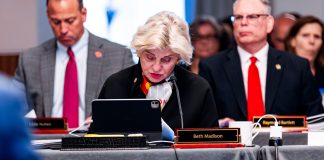White House Press Secretary Karoline Leavitt is facing backlash for her reaction to the Texas floods that killed over 90 people over the Fourth of July weekend.
During a White House briefing on Monday afternoon, Leavitt blamed Democrats for politicizing the floods in Texas and claimed that the National Weather Service (NWS) was overstaffed, contrary to reports indicating understaffing during the event.

“Democrat elected officials are trying to turn this into a political game, and it is not,” Leavitt said. “This is a national tragedy, and the administration is treating it as such.”
Severe floods ravaged central Texas from July 4, with significant rainfall causing rapid rises in water levels along the Guadalupe River, leading to multiple flash flood emergencies that required state emergency response activation. Many are questioning the National Weather Service’s response, especially in light of reported recent cuts to the agency.
“We know the National Weather Service provided early and consistent warnings. They gave out timely flash flood alerts,” Leavitt added. “There were record-breaking lead times in the lead-up to this catastrophe, there is ongoing flood monitoring, and these offices were well-staffed. In fact, one of the offices was actually overstaffed they had more people than they need. So any claim to the contrary is completely false. And it’s just sad that people are pushing these lies.”
Meteorologists and former NWS officials have warned that chronic staffing shortages, worsened by federal budget cuts and layoffs, have led to reduced communication and fewer weather balloon launches, potentially impacting forecast accuracy and emergency response.
DemocratIc Texas Rep. Joaquin Castro on Sunday called for an investigation into the possible role of NWS staffing cuts in issuing warnings and responding to the tragedy.
Castro recommended the probe after CNN’s Dana Dash said during an on-air interview that a director of the NWS union told the news organization that the Austin/San Antonio office “is missing a warning coordination meteorologist due to the Trump administration’s buyouts.”
As of Monday afternoon, there is no clear indication of what the staffing roster was for the seven counties that were impacted by the flooding, which killed nearly 30 children at a popular summer camp. However, Jason Runyen, a meteorologist in the New Braunfels office, which covers the Austin/San Antonio area, told The Associated Press that “there were extra people.”
While there are usually two during normal weather, there were five that night, Runyen told the outlet.
Still, the mayor of Kerr County, which was devastated by the storm, said he did not receive a flood warning or notification.
An X user who claims to live 45 minutes away from Kerrville stated that she did not receive any alerts.
Some experts told Politico that the lack of leadership at key local weather offices is concerning, especially in areas hardest hit by the floods. The NWS office in San Angelo, which covers some of those communities, doesn’t have a permanent meteorologist in charge. And the Austin/San Antonio office is missing both its warning coordination meteorologist and science and operations officer, according to a June vacancy list.
These roles are imperative. They’re the go-betweens who help turn weather forecasts into clear, usable action plans for local emergency managers. Still, it’s unclear if these vacancies affected communication during the flood.
Critics also called out Leavitt for deflecting responsibility after she stated that the floods were an “act of God,” and there was nothing the administration could do about it, following questions about the timing of the warnings.
Local officials also complained that the warnings that were sent were in the wee hours of the morning, and many people were unaware of the severity.
“Well, the alerts imminently were sent out before the flood when people were sleeping because the flood hit in the very early hours of the morning, so people were sleeping in the middle of the night when this flood came, that was an act of God it’s not the administration’s fault that the flood hit when it did, but there were early and consistent warnings and again the National Weather Service did its job,” she said.
According to reports, the first flood watch was issued at 1:18 p.m. on July 3, before the rain even began. Then, around 11:41 p.m., officials issued flash flood warnings, and by 4:03 a.m. on July 4, it was upgraded to a flood emergency. The water started rising fast between 4 and 5 AM, with the Guadalupe River jumping 30 feet in just minutes. That means there were about three hours of warning, but the worst of it hit while most people were still asleep.
Meteorologists can usually identify the potential for severe storms days ahead, thanks to advanced models and satellite data. But it’s still tough to say exactly how much rain a storm will drop or how long it’ll sit over one spot, especially when looking a few days out. As new information is received from radar, satellites, and ground reports, the forecast is continually updated. The closer the storm gets, the clearer the picture becomes.
“Calling it an ‘act of God’ doesn’t absolve leaders from their duty to act,” one critic wrote. “If alerts went out too late to save lives, that’s not divine timing; it’s a failure of the TACO administration.”
“Will this administration ever take accountability for anything they do or lack thereof?” another person asked.
However, some argue that local and state officials are to blame for the shortcomings, as reports indicate that lawmakers in the Republican-led Legislature failed to pass a bill that would improve disaster warning systems.
“All the focus right now is let’s save all the lives we can,” GOP state Rep. Wes Virdell told The Texas Tribune. “I can tell you in hindsight, watching what it takes to deal with a disaster like this, my vote would probably be different now. … I think even if you had a warning system there, this came in so fast and early in the morning it’s very unlikely the warning system would have had much effect.”
The New York Times also reported that Kerr County officials considered installing sirens and early flooding monitors along the Guadalupe River, where many youth camps are located, about eight years ago, but opted against it due to the costs. Talks about the system resurfaced as recently as May, the Times reports.
“Bunch of scapegoating going on,” another person summed it up.
Great Job Nyamekye Daniel & the Team @ Atlanta Black Star Source link for sharing this story.





